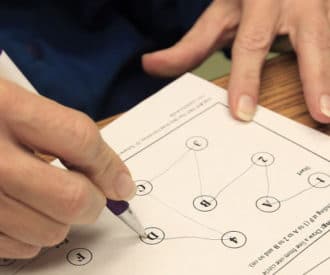
Approaching someone with dementia sets the tone, and believe it or not, there's a right and a wrong way to approach your patient or loved one. In this article, we'll get some advice from the amazing Teepa Snow on how to best approach someone with dementia. Enjoy!
A positive approach sets you up for dementia care success
Something as simple as how you approach (walk up to or start interacting with) someone with Alzheimer’s disease or dementia can set the tone for the whole interaction.
Because the person with dementia’s brain has been damaged, they’re no longer processing information in the same way we do.
That’s why our natural instincts for approaching someone might seem scary or aggressive from their point of view.
If we unintentionally startle them, it can trigger their natural “fight or flight” response and cause conflict.

Learning to approach someone in a non-threatening way sets the stage for a positive interaction.
And helping someone feel at ease makes it much more likely that they’ll cooperate with the task at hand.
We found an excellent free video in which expert dementia educator Teepa Snow demonstrates successful techniques for approaching someone with dementia.
She also shows why some of our approaches can seem scary or threatening – the opposite of our kind intentions.
This 8 minute video clip is from a training class that Teepa is giving to assisted living staff, but the techniques are 100% applicable to any caregiving situation.
Having her demonstrate on staff members brings the scenario to life and makes it easy to see how common actions could be misinterpreted.
Here, we highlight Teepa’s 6 key techniques for a non-threatening way to approach someone with dementia.
6 essential techniques for how to approach someone with dementia
1. Approach from the front, never from behind (35 seconds in video)
- It’s a natural human response to be startled by or uncomfortable with someone unseen coming up from behind and touching them or getting right in their face.
- The person might respond with fight (hitting out), flight (trying to get away), or fright (freezing and grabbing onto something).
- What this approach can look like from their perspective – at 2:13 in the video
2. Approach very slowly to give their brain time to process (3:12 in video)
- If you zoom up (from their damaged brain’s perspective), they’ll be startled and again respond with fight, flight, or fright.
- A good pace is to count “one-one-thousand” per step.
3. Avoid a confrontational stance (4:32 in video)
- Instead of standing right in front of (and over) someone, take a supportive stance. Stand at arms length at their side (the dominant, writing-hand side is preferred because it instinctively makes them feel more comfortable).
- What this looks like from their perspective – at 4:41 in the video
- Pro tip: Don’t mistake a smile or laugh for true comfort or happiness. It could be a nervous smile or laugh while they’re uncomfortable and figuring out how to respond. See the volunteer’s nervous laughter at 6:05 in the video when Teepa looms over him.
4. Crouch down to eye level or below, don’t bend forward (6:34 in video)
- Bending forward puts your face too close to theirs, causing discomfort
- They feel like they're in control, so they’re more likely to cooperate
5. Offer your hand, don’t grab or pull (7:11 in video)
- When someone grabs or pulls you, you automatically pull away and resist.
- When you offer your hand, they choose to take it, which makes them more likely to cooperate.
6. Putting it all together (7:48 in video)
- In this section, Teepa combines all the steps and demonstrates how to approach the person in a way that is most likely to be comfortable for them.
- Pro tip: Notice Teepa’s hand position and how she takes his hand (7:55 in video). This hand-under-hand position is an essential technique that she often teaches. This hand position is the safest for both of you, provides greater comfort to the person with dementia, and gives you more control.
Next Step Get a demonstration on how to approach someone with dementia in a positive, non-threatening way (8 min)
Recommended for you:
- Dementia and Eyesight: An Expert Explains 3 Common Changes and Behaviors
- 9 Ways to Reduce Anger in Dementia
- Responding to 4 Common Dementia Accusations: Stealing, Poisoning, Being Held Prisoner
This article wasn’t sponsored and doesn’t contain affiliate links. For more information, see How We Make Money.
About the Author

Connie Chow
Connie was a hands-on caregiver for her grandmother for 20 years. (Grandma made it to 101 years old!) She knows how challenging, overwhelming, and all-consuming caring for an older adult can be. She also knows how important support is — especially in the form of practical solutions, valuable resources, and self-care tips.




